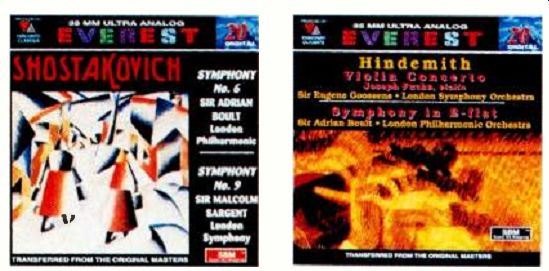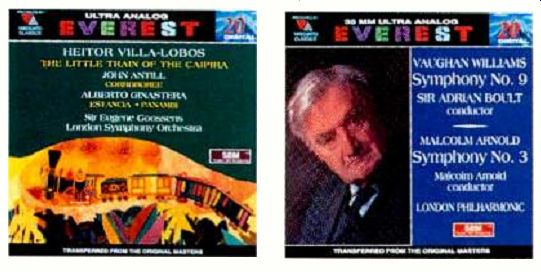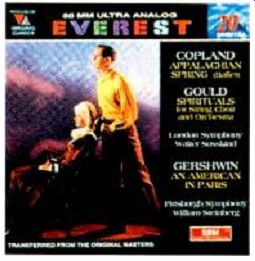REVIEWING EVEREST
The first 12 CDs in Vanguard Classics' ambitious Everest reissue series are now on the market, and what a marvelous venture it is! Accordingly, I am devoting this month's column to capsule reviews of most of these items--but first, a brief look at the series overall.

The basic A/D transfers from the 35-year-old masters are nearly flaw less. What problems were encountered have apparently been so successfully dealt with that no blemish is obvious. Supervised by Vanguard president Seymour Solomon, the transfer process employed vintage equipment to accommodate the original three-track masters, some of which are on 35-mm magnetic film, the others on standard half-inch 15-ips magnetic tape. Further restoration, using Sony's Super Bit Mapping, was carried out primarily by Sony Classical. (See last month's "Currents.") You will not be aware of any striking technological differences between the two formats of the original masters, but close listening will reveal that the film-based recordings are slightly quieter.
The CD packaging is simple but appropriate. Excepting the 16-page booklet for the Beethoven Sym phonies, liner notes are given in an insert of two or three panels, sufficient space to carry the original notes or a slightly abridged version of them. The notes were written by prominent individuals in record an notation, including David Hall and Paul Affelder. A generic insert in each CD gives technical information common to all the releases as well as details on future releases (the next group is expected momentarily).
The recordings in this first wave of reissues were all originally re leased over a busy four-year period, from 1958 to 1961. Most of them were made in London-and of these, all but one were recorded at Walthamstow Assembly Hall in the suburbs. Walthamstow, as it is known, is still used for town meetings, boxing matches, and, when it is available, recording sessions. There is a stage at one end, and the main floor seating can be removed, making it possible to place the performing ensemble directly in the middle of the acoustical space.


In Walthamstow, original Everest recording engineer Bert Whyte had his ideal recording venue. The room sounded back immediately, and the balance between direct and reverberant sound could easily be adjusted, section by section, by moving the players as required. No wonder that Walthamstow could handle music from just about all corners of the repertory. (All recordings listed below were made at Walthamstow, unless otherwise indicated. Dates given are original release dates.) Falla: The Three-Cornered Hat, London Symphony Orchestra/Jorda (1960); Bartok: Dance Suite, Lon don Philharmonic Orchestra/Ferencsik (1959); Everest/Vanguard Classics EVC 9000. The Falla is very idiomatic, and Enrique Jorda knows exactly when to bend and shape the tempos, particularly in the non-dance sections. While present-day conductors are apt to rush this mu sic, Jorda keeps the dance tempos on the moderate side. The sound is vintage Walthamstow. Janos Ferencsik shows much the same attention to the Magyar aspects of Bartok's grip ping Dance Suite. Appropriately, the mikes are a bit closer, emphasizing the sardonic, diabolical aspect of the work. The six dances are based largely on Bartok's extensive ethno musicological research into native Hungarian folk music. They are played without interruption and are connected by a ritornello whose haunting and wistful nature is the very essence of Bartok.

Vaughan Williams: Symphony No. 9, LPO/Boult (1958); Arnold: Symphony No. 3, LPO/Arnold (1959); EVC 9001.
The Ninth Symphony was recorded just hours after the composer died, and this reissue includes (for the first time on disc) a short eulogy spoken by Sir Adrian Boult.
The music has much the same brooding, often jarring, non-pastoral quality that had been introduced in the Sixth Sym phony. The writing is complex but always clear, and it makes skillful use of a saxophone section clearly independent of the standard orchestral winds. Boult's affinity for Vaughan Williams is shown better here than in his EMI recordings. Arnold's sym phony is reminiscent of his many overtures (short movements, lilting rhythms) and is thoroughly entertaining.
Rachmaninoff: Symphonic Dances; Stravinsky: The Rite of Spring, LSO/ Goossens (1958, 1960); EVC 9002. This is one of the great Symphonic Dances. Today, most conductors take the first movement too fast, robbing it of majesty and elegance.
Sir Eugene Goossens gets it just right. The waltz and the final Allegro vivace are taken at more familiar tempos. The Stravinsky, with Bert Whyte's normal Walthamstow setup, comes across at what you might call "mid-perspective," which I prefer over the close-up perspectives favored by many conductors and producers today. Sane tem pos throughout.
Copland: Appalachian Spring; Gould: Spirituals for String Choir and Orchestra, LSO/Susskind (1958); Gershwin: An American in Paris, Pittsburgh Symphony Orchestra/Steinberg (1960); EVC 9003.
There are many accounts of Appalachian Spring to choose from, and this one measures up nicely. But the real find here is Gould's Spirituals, by far the best available recording of this marvelous work. Here is the essence of what Whyte's three-mike approach was all about: The balance between direct and room sound is ideal, and the sense of depth is remarkable. Listen for the various percussion details. They are all just where they should be-bass drum, anvil, cymbals, and all the rest. As for An American in Paris ... , in the entire body of Everest recordings, there are no more than a handful that do not measure up to Whyte's high standards, and this recording is one of them. The Pittsburgh orchestra does not play at its best, and the recording in Heinz Hall simply does not have the bloom of Walthamstow.
Strauss: "Till Eulenspiegel's Merry Pranks"; "Don Juan"; "Dance of the Seven Veils" from Salome, Stadium Symphony Orchestra of New York/Stokowski (1959); Canning: Fantasy on a Hymn Tune, Houston Symphony Orchestra/ Stokowski (1960); EVC 9004.
The Stadium Symphony is, in fact, the New York Phil harmonic Orchestra. At the time of this recording, the NYPO was under contract to Columbia, so another name had to be used. Manhattan Center, the recording venue for the Strauss, is a large ballroom that was much used for orchestral recording back in the 1960s and is still available today. The Strauss is played as only Stoky could do it, with grand sweep and momentum. And certainly the orchestra could keep up with him technically. Sonically, the immediacy of the room's reverberation fleshes out the music, giving it a quality similar to Walthamstow but not quite as expansive. The Canning work, taped at Jones Hall in the Houston Civic Center, is sort of an American version of Vaughan Williams' Fantasia on a Theme by Thomas Tallis. It is played and recorded beautifully.
Shostakovich: Symphony No. 6, LPO/ Boult (1958); Symphony No. 9, LSO/Sargent (1960); EVC 9005.
The Sixth opens with a 20-minute Largo that moves freely from tension to release, followed by a contrasting pair of short scherzos. The Ninth is as different as it can be, a set of five relatively short movements in the classical mold.
Vaughan Williams: Job; Overture to The Wasps, LPO/Boult (1959); Arnold: Four Scottish Dances, LPO/Arnold (1959); EVC 9006.
The cavernous acoustics of the Royal Albert Hall give something of a medieval mystery-play quality to the work based on William Blake's Illustrations for the Book of Job. Literal representations abound, and the depiction of the devil by oily slides on the saxophone is typical of the composer's tone-painting. The Overture to Aristophanes' play is one of Vaughan Williams' most engaging short works, and Arnold's spritely Scottish Dances (recorded at Walthamstow) complement it nicely.
Villa-Lobos: "The Little Train of the Caipira"; Antilb "Corroboree"; Ginastera: "Estancia," "Panambi," LSO/Goossens (1958, except Villa-Lobos, 1960); EVC 9007. These works draw on ethnic material from the composers' native countries of Brazil, Australia, and Argentina. The scores are all gorgeous, with lots of exotic percussion, and acoustics to match. The recordings are still of demonstration quality.
Bartok: Concerto for Orchestra, Houston/Stokowski (1961); Kodaly: "Psalmus Hungaricus," LPO/Ferencsik (1959); EVC 9008.
This Bartok recording shows once again how underrated Leopold Stokowski is today. It is a beautiful performance that holds its own with any in the catalog. Janos Ferencsik's account of Kodaly's "Psalmus" suffers a little from its English translation but otherwise is idiomatically well done. Jones Hall in Houston, the venue for the Bartok, sounds very good.
Hindemith: Violin Concerto, J. Fuchs/ LSO/Goossens (1959); Symphony in E-flat, LPO/Boult (1958); EVC 9009.
Hindemith was still in his heyday when these recordings were made. His star has since set let's hope temporarily. This music is too good to be missed, and a generation has grown up knowing almost nothing of the man. Both performances are beautifully done and highly recommended.

Apart from a sampler, The Sound of Everest (EVC 9050), the one remaining item in this first wave of Everest reissues is a five-CD set given over to Josef Krips' traversal of the Beethoven Symphonies with the London Symphony Orchestra (EVC 9010/14). Time and space don't allow a survey here, but take my word that it is a handsome, well-annotated set, with notes by Krips himself.
(adapted from Audio magazine, Feb. 1995)
= = = =